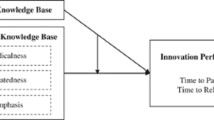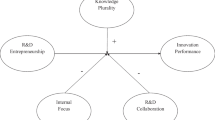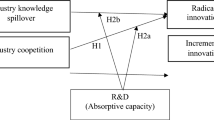Abstract
The timely disengagement of a firm from its old technological achievements and the update of its core technological competencies are important issues for both management scholars and practitioners. However, a firm is naturally reluctant to abandon or replace technologies created internally and on which a large amount of resources has been spent and with which the firm is to a large extent familiar. Addressing the temporal dimension of knowledge inputs, this study develops two hypotheses that examine the effect of the recency of internal knowledge inputs on innovation performance and how this effect is moderated by internal focus. We test these hypotheses on longitudinal economic and patent data from a sample of 139 firms from the pharmaceuticals, biotechnology, and chemicals industries for a 7-year period, using fixed-effects negative binomial regression models. Findings support that the recency of internal knowledge inputs is a positive predictor of both innovation productivity and impact; however, when the recency interacts with internal focus, both the effects become negative.
Similar content being viewed by others
References
Adner, R., & Snow, D. (2010). Old technology responses to new technology threats: Demand heterogeneity and technology retreats. Industrial and Corporate Change, 19(5), 1655–1675.
Ahuja, G. (2000). Collaboration networks, structural holes, and innovation: A longitudinal study. Administrative Science Quarterly, 45(3), 425–455.
Ahuja, G., & Katila, R. (2004). Where do resources come from? The role of idiosyncratic situations. Strategic Management Journal, 25(8–9), 887–907.
Ahuja, G., & Morris Lampert, C. (2001). Entrepreneurship in the large corporation: A longitudinal study of how established firms create breakthrough inventions. Strategic Management Journal, 22(6–7), 521–543.
Alencar, M. S. M., Porter, A. L., & Antunes, A. M. S. (2007). Nanopatenting patterns in relation to product life cycle. Technological Forecasting and Social Change, 74(9), 1661–1680.
Argyres, N. S., & Silverman, B. S. (2004). R&D, organization structure, and the development of corporate technological knowledge. Strategic Management Journal, 25(8–9), 929–958.
Capaldo, A., Lavie, D., & Petruzzelli, A. M. (2017). Knowledge maturity and the scientific value of innovations: The roles of knowledge distance and adoption. Journal of Management, 43(2), 503–533.
Carnabuci, G., Operti, E., & Kovács, B. (2015). The categorical imperative and structural reproduction: Dynamics of technological entry in the semiconductor industry. Organization Science, 26(6), 1734–1751.
Cattani, G. (2005). Preadaptation, firm heterogeneity, and technological performance: A study on the evolution of fiber optics, 1970–1995. Organization Science, 16(6), 563–580.
Cecere, G., & Ozman, M. (2014). Innovation, recombination and technological proximity. Journal of the Knowledge Economy, 5(3), 646–667.
Cozzolino, A., & Rothaermel, F. T. (2018). Discontinuities, competition, and cooperation: Coopetitive dynamics between incumbents and entrants. Strategic Management Journal, 39(12), 3053–3085.
Cuellar S., Méndez-Morales A., & Herrera, M.M. (2021). Location matters: A novel methodology for patent's national phase process. Journal of the Knowledge Economy: 1–26.
De Carolis, D. M. (2003). Competencies and imitability in the pharmaceutical industry: An analysis of their relationship with firm performance. Journal of Management, 29(1), 27–50.
De Massis, A., Frattini, F., Kotlar, J., Petruzzelli, A. M., & Wright, M. (2016). Innovation through tradition: Lessons from innovative family businesses and directions for future research. Academy of Management Perspectives, 30(1), 93–116.
Fallatah, M. I. (2021). Innovating in the desert: A network perspective on knowledge creation in developing countries. Journal of the Knowledge Economy, 12(3), 1533–1551.
Filippetti, A., & Archibugi, D. (2011). Innovation in times of crisis: National systems of innovation, structure, and demand. Research Policy, 40(2), 179–192.
Fleming, L. (2001). Recombinant uncertainty in technological search. Management Science, 47(1), 117–132.
Forés, B., & Camisón, C. (2016). Does incremental and radical innovation performance depend on different types of knowledge accumulation capabilities and organizational size?. Journal of Business Research, 69(2), 831–848.
George, G., Kotha, R., & Zheng, Y. (2008). Entry into insular domains: A longitudinal study of knowledge structuration and innovation in biotechnology firms. Journal of Management Studies, 45(8), 1448–1474.
Gittelman, M., & Kogut, B. (2003). Does good science lead to valuable knowledge? Biotechnology firms and the evolutionary logic of citation patterns. Management Science, 49(4), 366–382.
Harhoff, D., & Reitzig, M. (2004). Determinants of opposition against EPO patent grants - The case of biotechnology and pharmaceuticals. International Journal of Industrial Organization, 22(4), 443–480.
Heeley, M. B., & Jacobson, R. (2008). The recency of technological inputs and financial performance. Strategic Management Journal, 29(7), 723–744.
Hock-Doepgen, M., Clauss, T., Kraus, S., & Cheng, C.-F. (2020). Knowledge management capabilities and organizational risk-taking for business model innovation in SMEs. Journal of Business Research.
Hoetker, G., & Agarwal, R. (2007). Death hurts, but it isn’t fatal: The postexit diffusion of knowledge created by innovative companies. Academy of Management Journal, 50(2), 446–467.
Joshi, A. M., & Nerkar, A. (2011). When do strategic alliances inhibit innovation by firms? Evidence from patent pools in the global optical disc industry. Strategic Management Journal, 32(11), 1139–1160.
Jung, H. J., & Lee, J. J. (2016). The quest for originality: A new typology of knowledge search and breakthrough inventions. Academy of Management Journal, 59(5), 1725–1753.
Kamuriwo, D. S., Baden-Fuller, C., & Zhang, J. (2017). Knowledge development approaches and breakthrough innovations in technology-based new firms. Journal of Product Innovation Management, 34(4), 492–508.
Katila, R. (2002). New product search over time: Past ideas in their prime? Academy of Management Journal, 45(5), 995–1010.
Kim, C., Song, J., & Nerkar, A. (2012). Learning and innovation: Exploitation and exploration trade-offs. Journal of Business Research, 65(8), 1189–1194.
Kim, M. (2016). Geographic scope, isolating mechanisms, and value appropriation. Strategic Management Journal, 37(4), 695–713.
Kouton, J., Bétila, R. R., & Lawin, M. (2021). The impact of ICT development on health outcomes in Africa: Does economic freedom matter?. Journal of the Knowledge Economy, 12(4), 1830–1869.
Lahiri, N., & Narayanan, S. (2013). Vertical integration, innovation, and alliance portfolio size: Implications for firm performance. Strategic Management Journal, 34(9), 1042–1064.
Leone, M. I., & Reichstein, T. (2012). Licensing-in fosters rapid invention! The effect of the grant-back clause and technological unfamiliarity. Strategic Management Journal, 33(8), 965–985.
Lettl, C., Rost, K., & Von Wartburg, I. (2009). Why are some independent inventors ‘heroes’ and others ‘hobbyists’?. The moderating role of technological diversity and specialization. Research Policy, 38(2), 243–254.
Magelssen, C. (2019). Allocation of property rights and technological innovation within firms. Strategic Management Journal.
Mayer, M. C. J., Stadler, C., & Hautz, J. (2015). The relationship between product and international diversification: The role of experience. Strategic Management Journal, 36(10), 1458–1468.
McFadyen, M. A., Semadeni, M., & Cannella, A. A., Jr. (2009). Value of strong ties to disconnected others: Examining knowledge creation in biomedicine. Organization Science, 20(3), 552–564.
Miller, D. J., Fern, M. J., & Cardinal, L. B. (2007). The use of knowledge for technological innovation within diversified firms. Academy of Management Journal, 50(2), 307–325.
Moncada-Paternò-Castello, P., Ciupagea, C., Smith, K., Tübke, A., & Tubbs, M. (2010). Does Europe perform too little corporate R&D? A comparison of EU and non-EU corporate R&D performance. Research Policy, 39(4), 523–536.
Nemet, G. F., & Johnson, E. (2012). Do important inventions benefit from knowledge originating in other technological domains?. Research Policy, 41(1), 190–200.
Nerkar, A. (2003). Old is gold? The value of temporal exploration in the creation of new knowledge. Management Science, 49(2), 211–229.
Onal Vural, M., Dahlander, L., & George, G. (2013). Collaborative benefits and coordination costs: Learning and capability development in science. Strategic Entrepreneurship Journal, 7(2), 122–137.
Operti, E., & Carnabuci, G. (2014). Public knowledge, private gain: The effect of spillover networks on firms’ innovative performance. Journal of Management, 40(4), 1042–1074.
Papazoglou, M. E., & Spanos, Y. E. (2018). Bridging distant technological domains: A longitudinal study of the determinants of breadth of innovation diffusion. Research Policy, 47(9), 1713–1728.
Papazoglou, M. E., & Spanos, Y. E. (2021). Influential knowledge and financial performance: The role of time and rivals’ absorptive capacity. Technovation: 102-223.
Paruchuri, S., & Awate, S. (2017). Organizational knowledge networks and local search: The role of intra-organizational inventor networks. Strategic Management Journal, 38(3), 657–675.
Petruzzelli, A. M., Ardito, L., & Savino, T. (2018). Maturity of knowledge inputs and innovation value: The moderating effect of firm age and size. Journal of Business Research, 86, 190–201.
Petruzzelli, A. M., Rotolo, D., & Albino, V. (2012). The impact of old technologies on innovation: The case of the US biotechnology industry. Technology Analysis & Strategic Management, 24(5), 453–466.
Quintana-García, C., & Benavides-Velasco, C. A. (2008). Innovative competence, exploration and exploitation: The influence of technological diversification. Research Policy, 37(3), 492–507.
Rosenkopf, L., & Nerkar, A. (2001). Beyond local search: Boundary-spanning, exploration, and impact in the optical disk industry. Strategic Management Journal, 22(4), 287–306.
Rothaermel, F. T., & Alexandre, M. T. (2009). Ambidexterity in technology sourcing: The moderating role of absorptive capacity. Organization Science, 20(4), 759–780.
Rothaermel, F. T., & Hess, A. M. (2007). Building dynamic capabilities: Innovation driven by individual-, firm-, and network-level effects. Organization Science, 18(6), 898–921.
Rudy, B. C., & Black, S. L. (2018). Attack or defend? The role of institutional context on patent litigation strategies. Journal of Management, 44(3), 1226–1249.
Sakaki, H., & Jory, S. R. (2019). Institutional investors’ ownership stability and firms’ innovation. Journal of Business Research, 103, 10–22.
Sapsalis, E., van Pottelsberghe de la Potterie, B., & Navon, R. (2006). Academic versus industry patenting: An in-depth analysis of what determines patent value. Research Policy, 35(10), 1631–1645.
Schillebeeckx, S. J. D., Lin, Y., George, G., & Alnuaimi, T. (2020). Knowledge recombination and inventor networks: The asymmetric effects of embeddedness on knowledge reuse and impact. Journal of Management: 0149206320906865.
Seddighi, H. R. (2015). A model of a firm’s innovation and growth in a knowledge-based economy. Journal of the Knowledge Economy, 6(2), 215–227.
Sørensen, J. B., & Stuart, T. E. (2000). Aging, obsolescence, and organizational innovation. Administrative Science Quarterly, 45(1), 81–112.
Sorenson, O., & Fleming, L. (2004). Science and the diffusion of knowledge. Research Policy, 33(10), 1615–1634.
Tödtling, F., & Grillitsch, M. (2014). Types of innovation, competencies of firms, and external knowledge sourcing-findings from selected sectors and regions of Europe. Journal of the Knowledge Economy, 5(2), 330–356.
Vasudeva, G., & Anand, J. (2011). Unpacking absorptive capacity: A study of knowledge utilization from alliance portfolios. Academy of Management Journal, 54(3), 611–623.
Wiesenthal, T., Leduc, G., Haegeman, K., & Schwarz, H.-G. (2012). Bottom-up estimation of industrial and public R&D investment by technology in support of policy-making: The case of selected low-carbon energy technologies. Research Policy, 41(1), 116–131.
Wuyts, S., & Dutta, S. (2014). Benefiting from alliance portfolio diversity: The role of past internal knowledge creation strategy. Journal of Management, 40(6), 1653–1674.
Yayavaram, S., & Ahuja, G. (2008). Decomposability in knowledge structures and its impact on the usefulness of inventions and knowledge-base malleability. Administrative Science Quarterly, 53(2), 333–362.
Zapata-Cantu, L., Sanguino, R., Barroso, A., & Nicola-Gavrilă, L. (2022). Family business adapting a new digital-based economy: Opportunities and challenges for future research. Journal of the Knowledge Economy: 1–18.
Author information
Authors and Affiliations
Corresponding author
Additional information
Publisher's Note
Springer Nature remains neutral with regard to jurisdictional claims in published maps and institutional affiliations.
Rights and permissions
About this article
Cite this article
Papazoglou, M.E., Nelles, J. Keeping Pace with Technological Change: Insights into the Recency of Internal Knowledge Inputs. J Knowl Econ 14, 3724–3740 (2023). https://doi.org/10.1007/s13132-022-01023-9
Received:
Accepted:
Published:
Issue Date:
DOI: https://doi.org/10.1007/s13132-022-01023-9




